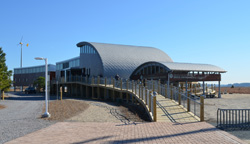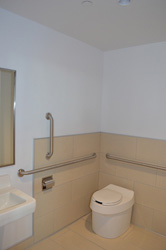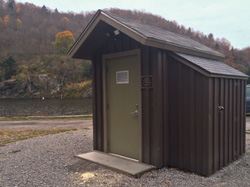Greetings from Clivus Multrum!
This seasonís Natural Solution News shows off the diversity of Clivus compost toilet applications. First, we visit Chesapeake Bay Foundation's new Brock Environmental Center, built to achieve both LEED Platinum and Living Building Challenge certifications. Next, we feature the Clivus M54 Trailhead composting toilet system at Moss Island Park in Little Falls, NY. The M54 Trailhead is a composter and building package designed especially for remote locations. Together, these projects demonstrate the flexibility of Clivus compost toilet systems.
Chesapeake Bay Foundation Continues Tradition of Building With the Bay in Mind
 |
Chesapeake Bay Foundation's Brock Environmental Center.* |
Chesapeake Bay Foundation, (CBF) recently opened its new Brock Environmental Center, built to achieve both LEED Platinum and Living Building Challenge (LBC) certifications. The 10,000 square foot building utilizes solar panels, wind turbines, geothermal wells, rain cisterns, and natural landscaping in addition to the Clivus composting toilet systems. The building provides office space for 24 CBF staff, office space for a local non-profit dedicated to the nearby Lynnhaven River, and conference space for meetings with local government, coalition partners, workshops and training events. CBF will also provide environmental education to 2,000-3,000 students per year at the Brock Environmental Center.
According to Paul Willey, CBF Director of Facilities, "The land acquisition through the design and construction was done in line with CBF's educational philosophy. The building is a teaching tool. The Brock Environmental Center was designed to meet, and even surpass, its water and energy needs with on-site rooftop solar panels and wind turbines, and by using rainwater for all of its water needs including drinking water."
Willey reports that the building uses 90% less water than a typical building of similar size, and 90% of that water reduction is attributed to the waterless Clivus composting toilet systems. The Clivus composting toilets were included because, Willey says, "We've been using Clivus since 1975 so we have strong experience with them. You cannot compete with the water savings in any other way. We know it, we trust it, and it works."
| "We've been using Clivus since 1975 so we have strong experience with them. We know it, we trust it, and it works." |
The design team secured permits for reuse of both the liquid and dry end products. The liquid end-product starts as urine but is transformed by bacteria in the Clivus into a stable, high-nutrient solution. It will be brought, periodically, to the local sanitation district facility where it will be added to the struvite reactor to produce a commercial fertilizer. The dry end-product is the composted feces, which, by the time it is removed, has a similar biological and chemical make-up as humus. Because the composting process reduces the volume by over 90%, it will be many years before any dry material is removed and used on site as a soil amendment.
Visitors to the Brock Center will have an opportunity to tour the building and learn how the various building systems work and the impact those systems have on the environment. Willey explains that the tours teach visitors about the water cycle and the connection to the bay, and will highlight the building's net zero impact on the land. He says that the Clivus composting toilet systems are included on the tour because they are "always a wow factor. When we get people connected to it and they start to understand it, it's a powerful teaching tool."
 |
Brock Environmental Center's restroom.** |
The Brock Center's design team decided to pursue Living Building Certification in addition to LEED Platinum because they wanted to push beyond what they have done before. In 2001, CBF opened the world's first LEED Platinum building,
the Philipp Merrill Environmental Center. When they recently discovered the LBC, the design team felt like it was very much in line with the organization's mission to "Save the Bay" and decided to pursue Living Building Certification as well as LEED Platinum for the Brock Environmental Center.
Both the LEED and Living Building Challenge programs go beyond conventional construction practices in their aim to reduce resource consumption, but LBC includes 20 design imperatives across seven categories: site, water, energy, health, materials, social equity and beauty. To be certified under the Challenge, "projects must meet a series of ambitious performance requirements over a minimum of 12 months of continuous occupancy."
The Brock Center celebrated its grand opening on November 16, 2014, and staff recently moved into the offices. The facilities team has worked to optimize all systems in anticipation of seasonal fluctuations. In accordance with LBC guidelines, they began their "challenge" on April 1, 2015, and will continue tracking the building's performance for the next twelve months. The results from this period will be submitted to the Living Building Challenge for certification. As the Director of Facilities, Willey is confident that the Brock Environmental Center will easily achieve the performance requirements during the occupancy period and will join the ranks of the most sustainable buildings in the world.
*Image courtesy of Russell H. Carlock, AIA
**Image courtesy of Chris Gorri/CB
A Turnkey Solution for Moss Island Park
 |
M54 Trailhead at Moss Island Park. |
Moss Island sits within the Mohawk River at Little Falls, NY, 25 miles east of Utica. Although it’s small (1500’ long by 625’ wide), Moss Island has lots to offer. Rock climbers come from far and wide to test their skills on any of 100 different routes. It’s also known for hanging potholes—up to fifty feet deep--which are unique geological features formed from erosion by floods from melting glaciers eons ago.
With all these features to draw visitors, a good toilet would come in handy. In 2014, Main Street First, a local community development organization, collaborated with a foundation connected to Colgate University, to install a Clivus M54 Trailhead. Because no sewer or electric is available at the park, the foundation determined that the M54W Trailhead would be the best option at the site. Main Street First worked with the Little Falls Department of Public Works to pass a resolution supporting the installation of the M54W on Moss Island.
All things considered, a turnkey operation was viewed as the most efficient way to proceed with the project. Clivus pre-fabricated the structure and delivered it, along with the compost tank, to the site for installation by a contractor with whom Clivus partnered for the project. The light-weight Clivus structure was lifted from the bottom using a backhoe. No other heavy equipment was necessary. Within a couple of days, the Clivus was up and running, with a custom solar-powered ventilation fan keeping the toilet room odorless.
Volunteers from Main Street First have taken on the maintenance of the M54W (with Clivus maintenance service as a back-up) and, according to Jayne Ritz of Main Street First, “the regular maintenance is an easy task.” After the installation of the M54W was completed, the group coordinated a community work day and volunteers painted benches, performed the regular maintenance, added gravel to the site and constructed a matching maintenance shed.
Visitors are pleased with the restroom addition and many have offered their compliments. Main Street First continues to be pleased with the ease of installation and maintenance of their M54 Trailhead.
*Image by Pete Septoff, Clivus Multrum, Inc.
Contact Clivus Multrum to see if a Clivus composting toilet system is right for your next project.
|
